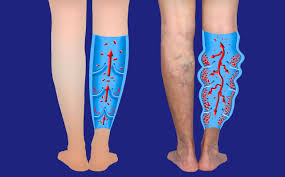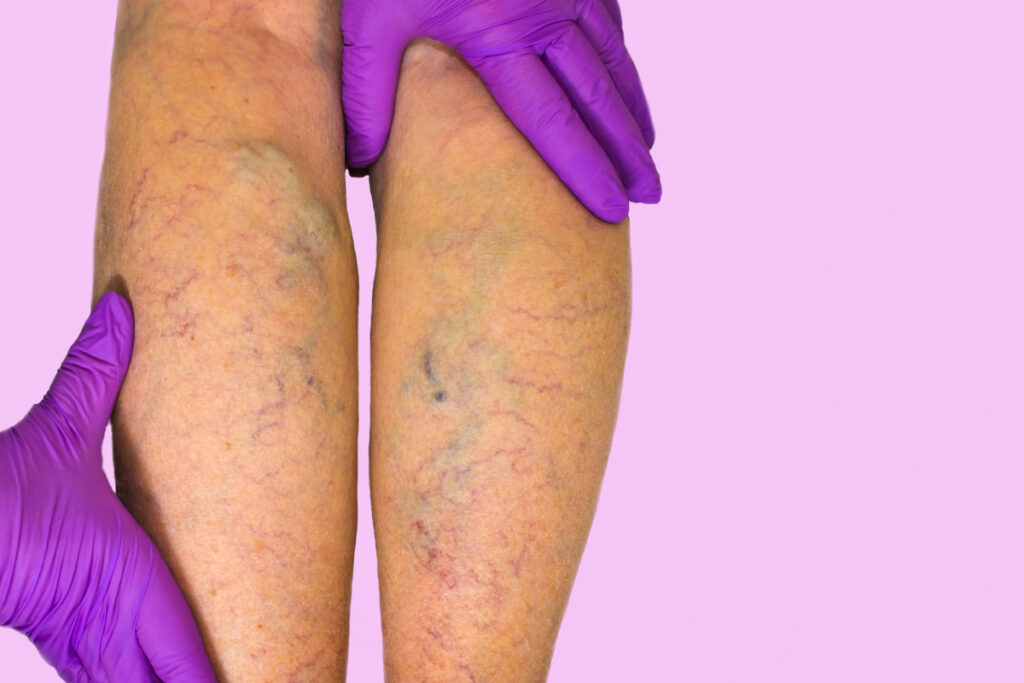Secondary Symptoms of Varicose Veins
Varicose veins are a common venous disorder characterized by enlarged, twisted veins, often visible just under the surface of the skin, typically in the legs. While the primary symptoms of varicose veins include visible bulging veins, aching, and heaviness in the legs, there are several secondary symptoms that may develop if the condition is not properly managed. These secondary symptoms are often more serious and can significantly impact an individual’s quality of life.
This article will discuss the secondary symptoms of varicose veins, including skin changes, edema, ulceration, and other complications that may arise as the condition progresses.

1. Skin Changes
One of the most noticeable secondary symptoms of varicose veins is changes in the skin overlying the affected veins. These changes often develop gradually and can indicate a worsening condition.
a. Hyperpigmentation
Hyperpigmentation refers to the darkening of the skin, usually around the ankles and lower legs. It occurs due to the leakage of red blood cells and other substances from the veins into the surrounding tissue. When these cells break down, they release iron, which causes the skin to become discolored, appearing brown or purplish. This discoloration can be persistent and may even darken over time.
b. Lipodermatosclerosis
Lipodermatosclerosis is a condition that involves inflammation of the skin and subcutaneous fat. It often presents as a hardening and tightening of the skin in the lower legs. The affected area may become tender, reddish, and firm to the touch, making the leg look tapered like an inverted champagne bottle. Lipodermatosclerosis is a sign of chronic venous insufficiency, which is the long-term pooling of blood in the veins and can lead to further complications if left untreated.
c. Venous Eczema (Stasis Dermatitis)
Venous eczema, also known as stasis dermatitis, is a type of inflammation that occurs as a result of poor venous circulation. The skin becomes red, scaly, itchy, and sometimes painful. This condition often occurs around the area of the varicose veins and can lead to cracked or oozing skin if not properly managed. Venous eczema is a signal that the venous system is under significant strain, and the skin’s barrier function has been compromised.
d. Atrophie Blanche
Atrophie blanche is characterized by small, white, scar-like areas on the skin, often surrounded by hyperpigmented skin. These areas are usually found around the ankles and result from poor blood flow, leading to decreased oxygen supply to the skin. Atrophie blanche can be painful and is often associated with a higher risk of skin ulceration.
2. Swelling (Edema)
Edema, or swelling of the legs, is another secondary symptom of varicose veins. This swelling occurs when blood pools in the veins, causing increased pressure and leakage of fluid into the surrounding tissues. Edema often becomes more noticeable at the end of the day, particularly after prolonged periods of standing or sitting.
a. Impact on Daily Activities
The swelling associated with varicose veins can make daily activities more challenging. Individuals may experience a feeling of heaviness or tightness in the legs, making it difficult to walk or engage in physical activities. In severe cases, edema can limit mobility and significantly reduce an individual’s quality of life.
b. Risk of Complications
Chronic edema can also increase the risk of complications such as skin infections, venous ulcers, and cellulitis. The stagnant fluid provides an environment where bacteria can thrive, making the skin more susceptible to infection.
3. Skin Ulceration (Venous Ulcers)
One of the most severe secondary symptoms of varicose veins is the development of venous ulcers. These ulcers are open sores that usually form around the ankles and lower legs, where blood circulation is most compromised. Venous ulcers occur when the pressure in the veins becomes so high that it prevents oxygen and nutrients from reaching the skin, leading to tissue breakdown.
a. Signs and Symptoms of Venous Ulcers
Venous ulcers are often preceded by skin changes such as hyperpigmentation, lipodermatosclerosis, and venous eczema. The skin becomes increasingly fragile, and even minor trauma can lead to the development of an ulcer. Venous ulcers are typically shallow, with irregular edges, and can be accompanied by significant pain, itching, and discharge.
b. Challenges in Healing
Venous ulcers are challenging to heal because they are caused by an underlying circulation problem. Without addressing the root cause of the venous insufficiency, the ulcer is likely to persist or recur. Treatment usually involves compression therapy to improve circulation, wound care, and, in some cases, surgical intervention.

4. Pain and Discomfort
While pain is a primary symptom of varicose veins, it can become more pronounced as the condition progresses. The intensity and nature of the pain can change over time, and it may become constant or more severe, particularly if complications like venous ulcers or lipodermatosclerosis develop.
a. Heaviness and Aching
Many individuals with varicose veins experience a persistent aching or throbbing sensation in their legs. This discomfort is often exacerbated by prolonged periods of standing or sitting and is typically worse at the end of the day. The heaviness can be debilitating, making it difficult for people to engage in daily activities.
b. Cramping and Restless Legs
Muscle cramping, particularly at night, is another secondary symptom associated with varicose veins. The poor circulation caused by varicose veins can lead to spasms and cramps, making it difficult to sleep comfortably. Restless legs syndrome, characterized by an uncontrollable urge to move the legs, can also be associated with varicose veins and contribute to sleep disturbances.
5. Bleeding
Varicose veins are located close to the surface of the skin and can be prone to bleeding if injured. Even minor trauma can cause a varicose vein to rupture, leading to significant bleeding. The skin overlying varicose veins is often fragile and thin, making it more susceptible to injury.
a. External Bleeding
External bleeding can occur if the skin over a varicose vein is cut or scraped. This bleeding can be difficult to control because of the high pressure in the affected vein. Immediate medical attention may be required to stop the bleeding and prevent further complications.
b. Internal Bleeding
In some cases, varicose veins can also lead to internal bleeding, causing bruising and tenderness around the affected area. This type of bleeding can be painful and may indicate that the condition is worsening.
6. Superficial Thrombophlebitis
Superficial thrombophlebitis is an inflammation of a vein near the surface of the skin, often accompanied by the formation of a blood clot. This condition is more common in people with varicose veins and can cause significant pain, redness, and swelling along the course of the affected vein.
a. Symptoms of Thrombophlebitis
The symptoms of superficial thrombophlebitis include a tender, red, and hard lump along the vein. The skin over the affected area may feel warm, and the vein may be visibly inflamed. Although superficial thrombophlebitis is generally less serious than deep vein thrombosis (DVT), it can still cause considerable discomfort and may increase the risk of further complications.
b. Risk of Deep Vein Thrombosis (DVT)
In some cases, superficial thrombophlebitis can extend into deeper veins, leading to deep vein thrombosis (DVT). DVT is a more serious condition that involves the formation of a blood clot in a deep vein, usually in the leg. If left untreated, DVT can lead to a pulmonary embolism, which is a life-threatening complication.
7. Restless Leg Syndrome (RLS)
Restless leg syndrome (RLS) is a condition characterized by an uncontrollable urge to move the legs, often accompanied by uncomfortable sensations. Many individuals with varicose veins report symptoms of RLS, particularly at night. The connection between RLS and varicose veins is thought to be related to poor venous circulation, which leads to discomfort and an urge to move the legs to improve blood flow.
a. Impact on Sleep Quality
RLS can significantly impact sleep quality, leading to fatigue and a reduced quality of life. Individuals with varicose veins who experience RLS may have difficulty falling asleep or staying asleep due to the constant need to move their legs.

Conclusion
Secondary symptoms of varicose veins can significantly impact an individual’s quality of life and may indicate a worsening of the condition. Skin changes, such as hyperpigmentation, lipodermatosclerosis, and venous eczema, are common secondary symptoms that can lead to further complications like venous ulcers. Swelling, pain, bleeding, and superficial thrombophlebitis are also potential consequences of untreated varicose veins. These secondary symptoms not only cause discomfort but also increase the risk of serious complications, such as deep vein thrombosis and skin infections.
It is crucial for individuals with varicose veins to seek medical attention if they notice any secondary symptoms. Early intervention can help prevent complications, improve quality of life, and, in some cases, halt the progression of the disease. Treatments such as compression therapy, lifestyle changes, and medical procedures can be highly effective in managing both primary and secondary symptoms of varicose veins.
A perfect Solution Of Varicose Veins Click Here



